独立主格with用法小全
- 格式:doc
- 大小:46.50 KB
- 文档页数:10
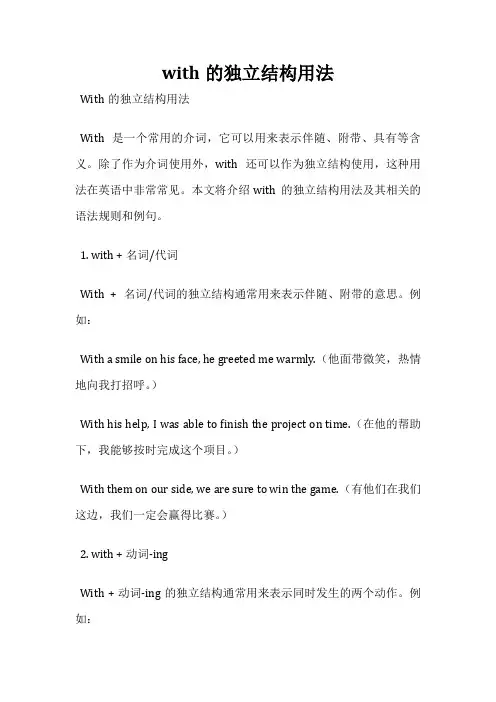
with的独立结构用法With的独立结构用法With是一个常用的介词,它可以用来表示伴随、附带、具有等含义。
除了作为介词使用外,with还可以作为独立结构使用,这种用法在英语中非常常见。
本文将介绍with的独立结构用法及其相关的语法规则和例句。
1. with + 名词/代词With + 名词/代词的独立结构通常用来表示伴随、附带的意思。
例如:With a smile on his face, he greeted me warmly.(他面带微笑,热情地向我打招呼。
)With his help, I was able to finish the project on time.(在他的帮助下,我能够按时完成这个项目。
)With them on our side, we are sure to win the game.(有他们在我们这边,我们一定会赢得比赛。
)2. with + 动词-ingWith + 动词-ing的独立结构通常用来表示同时发生的两个动作。
例如:With the sun shining brightly, we decided to go for a picnic.(阳光明媚,我们决定去野餐。
)With the children playing in the yard, the parents sat on the porch and chatted.(孩子们在院子里玩耍,父母们坐在门廊上聊天。
)With the music playing softly in the background, we enjoyed our dinner.(背景音乐轻柔地播放着,我们享受着晚餐。
)3. with + 不定式With + 不定式的独立结构通常用来表示目的、结果或条件。
例如:With a view to improving our service, we have launched a customer feedback program.(为了改善我们的服务,我们推出了客户反馈计划。
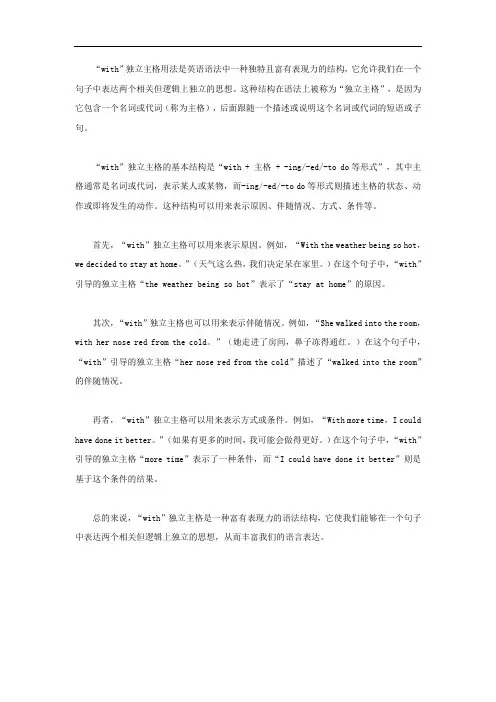
“with”独立主格用法是英语语法中一种独特且富有表现力的结构,它允许我们在一个句子中表达两个相关但逻辑上独立的思想。
这种结构在语法上被称为“独立主格”,是因为它包含一个名词或代词(称为主格),后面跟随一个描述或说明这个名词或代词的短语或子句。
“with”独立主格的基本结构是“with + 主格 + -ing/-ed/-to do等形式”,其中主格通常是名词或代词,表示某人或某物,而-ing/-ed/-to do等形式则描述主格的状态、动作或即将发生的动作。
这种结构可以用来表示原因、伴随情况、方式、条件等。
首先,“with”独立主格可以用来表示原因。
例如,“With the weather being so hot,we decided to stay at home。
”(天气这么热,我们决定呆在家里。
)在这个句子中,“with”引导的独立主格“the weather being so hot”表示了“stay at home”的原因。
其次,“with”独立主格也可以用来表示伴随情况。
例如,“She walked into the room,with her nose red from the cold。
”(她走进了房间,鼻子冻得通红。
)在这个句子中,“with”引导的独立主格“her nose red from the cold”描述了“walked into the room”的伴随情况。
再者,“with”独立主格可以用来表示方式或条件。
例如,“With more time,I could have done it better。
”(如果有更多的时间,我可能会做得更好。
)在这个句子中,“with”引导的独立主格“more time”表示了一种条件,而“I could have done it better”则是基于这个条件的结果。
总的来说,“with”独立主格是一种富有表现力的语法结构,它使我们能够在一个句子中表达两个相关但逻辑上独立的思想,从而丰富我们的语言表达。
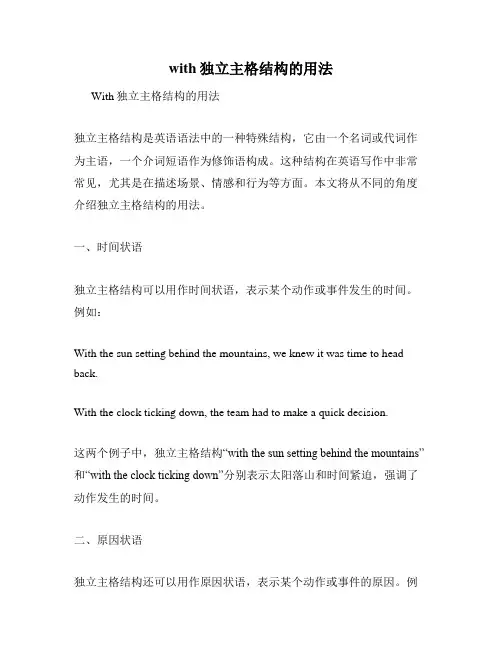
with独立主格结构的用法With独立主格结构的用法独立主格结构是英语语法中的一种特殊结构,它由一个名词或代词作为主语,一个介词短语作为修饰语构成。
这种结构在英语写作中非常常见,尤其是在描述场景、情感和行为等方面。
本文将从不同的角度介绍独立主格结构的用法。
一、时间状语独立主格结构可以用作时间状语,表示某个动作或事件发生的时间。
例如:With the sun setting behind the mountains, we knew it was time to head back.With the clock ticking down, the team had to make a quick decision.这两个例子中,独立主格结构“with the sun setting behind the mountains”和“with the clock ticking down”分别表示太阳落山和时间紧迫,强调了动作发生的时间。
二、原因状语独立主格结构还可以用作原因状语,表示某个动作或事件的原因。
例With the roads covered in snow, we had to cancel the trip.With the economy in recession, many people are struggling to find work.这两个例子中,独立主格结构“with the roads covered in snow”和“with the economy in recession”分别表示道路被雪覆盖和经济衰退,说明了动作或事件的原因。
三、方式状语独立主格结构还可以用作方式状语,表示某个动作或事件的方式。
例如:With a smile on her face, she greeted us warmly.With great care, he wrapped the fragile vase in bubble wrap.这两个例子中,独立主格结构“with a smile on her face”和“with great care”分别表示微笑和小心翼翼,说明了动作或事件的方式。
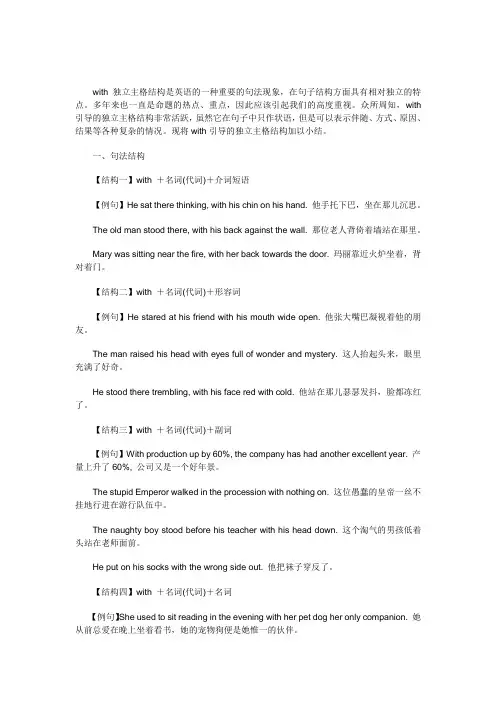
with独立主格结构是英语的一种重要的句法现象,在句子结构方面具有相对独立的特点。
多年来也一直是命题的热点、重点,因此应该引起我们的高度重视。
众所周知,with 引导的独立主格结构非常活跃,虽然它在句子中只作状语,但是可以表示伴随、方式、原因、结果等各种复杂的情况。
现将with引导的独立主格结构加以小结。
一、句法结构【结构一】with +名词(代词)+介词短语【例句】He sat there thinking, with his chin on his hand. 他手托下巴,坐在那儿沉思。
The old man stood there, with his back against the wall. 那位老人背倚着墙站在那里。
Mary was sitting near the fire, with her back towards the door. 玛丽靠近火炉坐着,背对着门。
【结构二】with +名词(代词)+形容词【例句】He stared at his friend with his mouth wide open. 他张大嘴巴凝视着他的朋友。
The man raised his head with eyes full of wonder and mystery. 这人抬起头来,眼里充满了好奇。
He stood there trembling, with his face red with cold. 他站在那儿瑟瑟发抖,脸都冻红了。
【结构三】with +名词(代词)+副词【例句】With production up by 60%, the company has had another excellent year. 产量上升了60%, 公司又是一个好年景。
The stupid Emperor walked in the procession with nothing on. 这位愚蠢的皇帝一丝不挂地行进在游行队伍中。
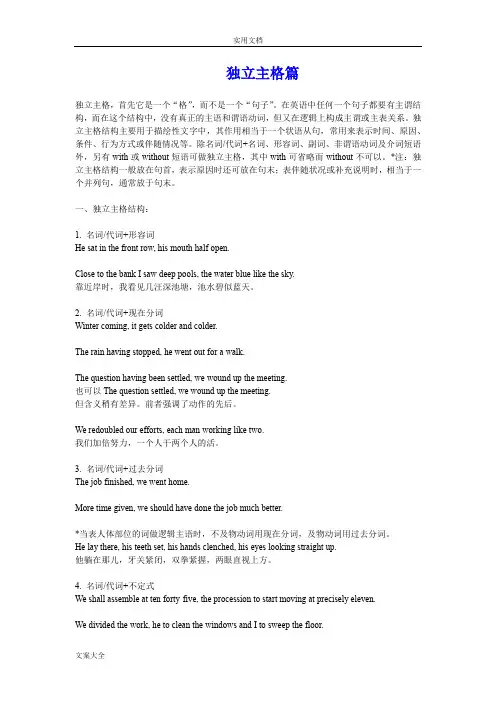
独立主格篇独立主格,首先它是一个“格”,而不是一个“句子”。
在英语中任何一个句子都要有主谓结构,而在这个结构中,没有真正的主语和谓语动词,但又在逻辑上构成主谓或主表关系。
独立主格结构主要用于描绘性文字中,其作用相当于一个状语从句,常用来表示时间、原因、条件、行为方式或伴随情况等。
除名词/代词+名词、形容词、副词、非谓语动词及介词短语外,另有with或without短语可做独立主格,其中with可省略而without不可以。
*注:独立主格结构一般放在句首,表示原因时还可放在句末;表伴随状况或补充说明时,相当于一个并列句,通常放于句末。
一、独立主格结构:1. 名词/代词+形容词He sat in the front row, his mouth half open.Close to the bank I saw deep pools, the water blue like the sky.靠近岸时,我看见几汪深池塘,池水碧似蓝天。
2. 名词/代词+现在分词Winter coming, it gets colder and colder.The rain having stopped, he went out for a walk.The question having been settled, we wound up the meeting.也可以The question settled, we wound up the meeting.但含义稍有差异。
前者强调了动作的先后。
We redoubled our efforts, each man working like two.我们加倍努力,一个人干两个人的活。
3. 名词/代词+过去分词The job finished, we went home.More time given, we should have done the job much better.*当表人体部位的词做逻辑主语时,不及物动词用现在分词,及物动词用过去分词。

with独立主格结构是英语中一种重要的句法现象,在句子结构方面具有相对独立的特点。
多年来也一直是命题的热点、重点,因此应该引起我们的高度重视。
众所周知,wi th引导的独立主格结构非常活跃,虽然它在句子中只作状语,但是可以表示伴随、方式、原因、结果等各种复杂的情况。
现将with引导的独立主格结构总结如下。
一、句法结构1. with +名词(代词)+介词短语He sat there thinking, with his chin on his hand.他手托下巴,坐在那儿沉思。
The old man stood there, with his back against thewall.那位老人背倚着墙站在那里。
Mary was sitting near the fire, with her back towards thedoor.玛丽*近火炉坐着,背对着门。
2. with +名词(代词)+形容词He stared at his friend with his mouth wide open.他张大嘴巴凝视着他的朋友。
The man raised his head with eyes full of wonder andmystery.这人抬起头来,眼里充满了好奇。
He stood there trembling, with his face red withcold.他站在那儿瑟瑟发抖,脸都冻红了。
3. with +名词(代词)+副词With production up by 60%, the company has had other excellentyear.产量上升了60%, 公司又是一个好年景。
The stupid Emperor walked in the procession with nothingon.这位愚蠢的皇帝一丝不挂地行进在游行队伍中。
The naughty boy stood before his teacher with hishead down.这个淘气的男孩低着头站在老师面前。
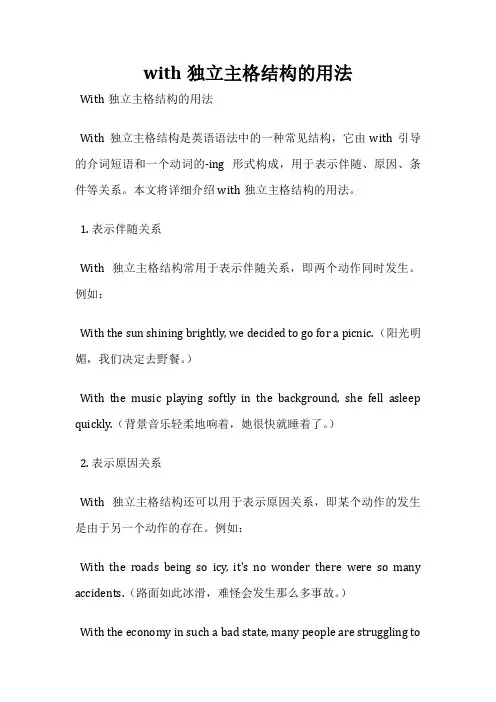
with独立主格结构的用法With独立主格结构的用法With独立主格结构是英语语法中的一种常见结构,它由with引导的介词短语和一个动词的-ing形式构成,用于表示伴随、原因、条件等关系。
本文将详细介绍with独立主格结构的用法。
1. 表示伴随关系With独立主格结构常用于表示伴随关系,即两个动作同时发生。
例如:With the sun shining brightly, we decided to go for a picnic.(阳光明媚,我们决定去野餐。
)With the music playing softly in the background, she fell asleep quickly.(背景音乐轻柔地响着,她很快就睡着了。
)2. 表示原因关系With独立主格结构还可以用于表示原因关系,即某个动作的发生是由于另一个动作的存在。
例如:With the roads being so icy, it's no wonder there were so many accidents.(路面如此冰滑,难怪会发生那么多事故。
)With the economy in such a bad state, many people are struggling tomake ends meet.(经济如此糟糕,许多人都在苦苦挣扎。
)3. 表示条件关系With独立主格结构还可以用于表示条件关系,即某个动作的发生是在某种条件下。
例如:With the weather being so unpredictable, we decided to bring both umbrellas and sunscreen.(天气如此不可预测,我们决定带上雨伞和防晒霜。
)With the deadline approaching, we worked late into the night to finish the project.(截止日期临近,我们熬夜工作以完成项目。
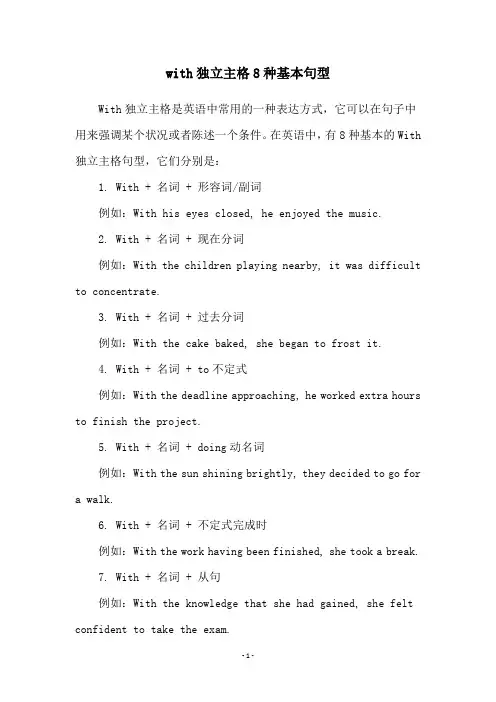
with独立主格8种基本句型With独立主格是英语中常用的一种表达方式,它可以在句子中用来强调某个状况或者陈述一个条件。
在英语中,有8种基本的With 独立主格句型,它们分别是:1. With + 名词 + 形容词/副词例如:With his eyes closed, he enjoyed the music.2. With + 名词 + 现在分词例如:With the children playing nearby, it was difficult to concentrate.3. With + 名词 + 过去分词例如:With the cake baked, she began to frost it.4. With + 名词 + to不定式例如:With the deadline approaching, he worked extra hours to finish the project.5. With + 名词 + doing动名词例如:With the sun shining brightly, they decided to go fora walk.6. With + 名词 + 不定式完成时例如:With the work having been finished, she took a break.7. With + 名词 + 从句例如:With the knowledge that she had gained, she felt confident to take the exam.8. With + 名词 + 介词短语例如:With his hand on her shoulder, he reassured her that everything would be alright.这8种With独立主格句型在英语中使用非常广泛,可以用来表达各种不同的情境和意思。
学会运用它们,能够让我们的英语表达更加地流畅自然。
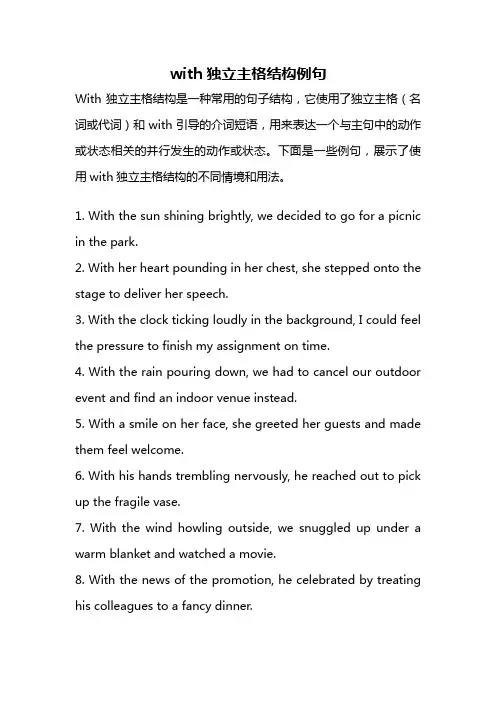
with独立主格结构例句With独立主格结构是一种常用的句子结构,它使用了独立主格(名词或代词)和with引导的介词短语,用来表达一个与主句中的动作或状态相关的并行发生的动作或状态。
下面是一些例句,展示了使用with独立主格结构的不同情境和用法。
1. With the sun shining brightly, we decided to go for a picnic in the park.2. With her heart pounding in her chest, she stepped onto the stage to deliver her speech.3. With the clock ticking loudly in the background, I could feel the pressure to finish my assignment on time.4. With the rain pouring down, we had to cancel our outdoor event and find an indoor venue instead.5. With a smile on her face, she greeted her guests and made them feel welcome.6. With his hands trembling nervously, he reached out to pick up the fragile vase.7. With the wind howling outside, we snuggled up under a warm blanket and watched a movie.8. With the news of the promotion, he celebrated by treating his colleagues to a fancy dinner.9. With a heavy heart, she packed her bags and said goodbye to her family as she left for college.10. With the car engine revving loudly, he sped off down the highway.以上是一些使用with独立主格结构的例句,它们展示了不同的情境和动作,并且符合标题要求。
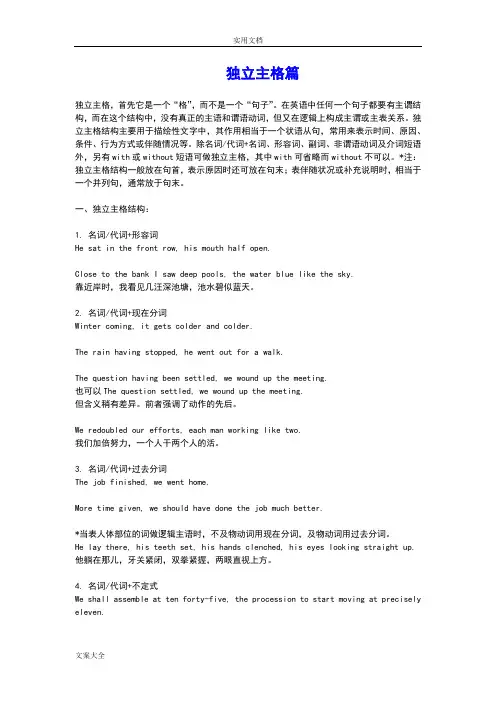
独立主格篇独立主格,首先它是一个“格”,而不是一个“句子”。
在英语中任何一个句子都要有主谓结构,而在这个结构中,没有真正的主语和谓语动词,但又在逻辑上构成主谓或主表关系。
独立主格结构主要用于描绘性文字中,其作用相当于一个状语从句,常用来表示时间、原因、条件、行为方式或伴随情况等。
除名词/代词+名词、形容词、副词、非谓语动词及介词短语外,另有with或without短语可做独立主格,其中with可省略而without不可以。
*注:独立主格结构一般放在句首,表示原因时还可放在句末;表伴随状况或补充说明时,相当于一个并列句,通常放于句末。
一、独立主格结构:1. 名词/代词+形容词He sat in the front row, his mouth half open.Close to the bank I saw deep pools, the water blue like the sky.靠近岸时,我看见几汪深池塘,池水碧似蓝天。
2. 名词/代词+现在分词Winter coming, it gets colder and colder.The rain having stopped, he went out for a walk.The question having been settled, we wound up the meeting.也可以The question settled, we wound up the meeting.但含义稍有差异。
前者强调了动作的先后。
We redoubled our efforts, each man working like two.我们加倍努力,一个人干两个人的活。
3. 名词/代词+过去分词The job finished, we went home.More time given, we should have done the job much better.*当表人体部位的词做逻辑主语时,不及物动词用现在分词,及物动词用过去分词。
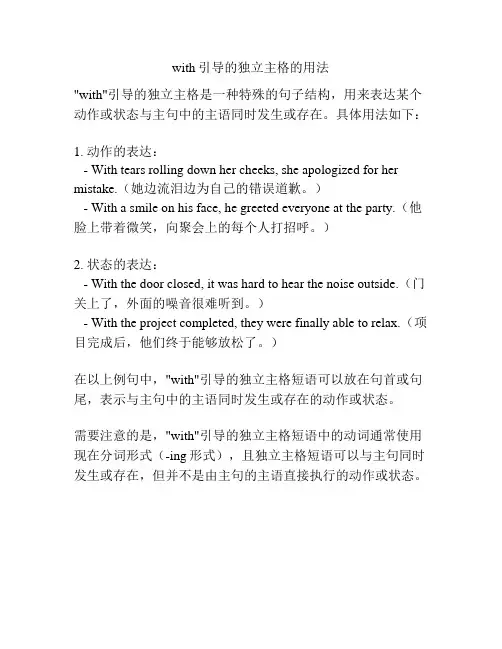
with引导的独立主格的用法
"with"引导的独立主格是一种特殊的句子结构,用来表达某个动作或状态与主句中的主语同时发生或存在。
具体用法如下:
1. 动作的表达:
- With tears rolling down her cheeks, she apologized for her mistake.(她边流泪边为自己的错误道歉。
)
- With a smile on his face, he greeted everyone at the party.(他脸上带着微笑,向聚会上的每个人打招呼。
)
2. 状态的表达:
- With the door closed, it was hard to hear the noise outside.(门关上了,外面的噪音很难听到。
)
- With the project completed, they were finally able to relax.(项目完成后,他们终于能够放松了。
)
在以上例句中,"with"引导的独立主格短语可以放在句首或句尾,表示与主句中的主语同时发生或存在的动作或状态。
需要注意的是,"with"引导的独立主格短语中的动词通常使用现在分词形式(-ing形式),且独立主格短语可以与主句同时发生或存在,但并不是由主句的主语直接执行的动作或状态。
with做独立主格的用法
在英语中,“with”可以作为独立主格的用法,通常用于表示伴随、时间、原因、条件等关系。
以下是“with”作为独立主格的用法示例:
1. 表示伴随:With a book in hand, he walked into the library. (他手里拿着一本书走进了图书馆。
)
2. 表示时间:With the sun shining brightly, we decided to have
a picnic. (在阳光明媚的时候,我们决定去野餐。
)
3. 表示原因:With all the work to do, he can't go out for dinner. (因为所有的工作都要做,他不能出去吃饭。
)
4. 表示条件:With enough time, we could have done the project better. (如果有足够的时间,我们能把项目做得更好。
)
5. 表示方式:With the help of the internet, people can learn new things easily. (在互联网的帮助下,人们可以很容易地学习新事物。
)
需要注意的是,“with”作为独立主格时,其后的名词或代词与主句的主语不是同一个,而是作为伴随、时间、原因、条件等的补充说明。
需要将“with”引导的短语中的动词省略,并在短语后加上逗号。
此外,如果独立主格的主语和主句主语不一致时,需要使用代词或名词代替原来的主语。
1。
with的6种独立主格结构With的6种独立主格结构介词with在英语中的使用非常广泛,除了作为介词外,它还可以用作独立主格结构。
本文将详细介绍with的6种独立主格结构。
一、With a smile"With a smile"是最常见的一种独立主格结构,意思是“微笑着”。
这个结构通常用于描述人们的表情和态度。
例如:- With a smile on her face, she greeted everyone who entered the room.- He left the office with a smile, feeling satisfied with his day's work.二、With caution"With caution"意思是“小心地”,表示谨慎或警惕。
这个结构通常用于描述人们在行动或决策时所采取的态度。
例如:- With caution, he approached the wild animal.- She opened the package with caution, not knowing what was inside.三、With pleasure"With pleasure"意思是“乐意地”,表示愿意或高兴地做某事。
这个结构通常用于回答别人的请求或邀请。
例如:- "Can you help me move this table?" "With pleasure!"- "Would you like to join us for dinner?" "With pleasure!"四、With difficulty"With difficulty"意思是“费力地”,表示某事情很难做到,需要付出很大努力。
with的独立主格结构With的独立主格结构(with的复合结构或介词结构)是英语句子中常见的一种语法结构,用来表示其中一种条件、伴随状态、方式等。
该结构由介词with引导,后面接名词短语、代词或动名词短语作宾语,宾语与句子的主语分开放置,构成独立的主格结构。
下面将详细介绍该结构的用法和示例。
1.表示伴随状态:With的独立主格结构可以用来表示其中一种伴随状态,即在主语动作进行的同时,还有其他状态、条件或伴随动作存在。
例如:- With a smile on her face, she greeted the guests at the door.(她面带微笑地迎接客人在门口。
)在她迎接客人的同时,她面带微笑。
- With his hands trembling, he signed his name on the documents.(他颤抖着的手,在文件上签了名。
)在他签字的时候,他的手在颤抖。
2.表示条件或原因:With的独立主格结构也可以表示其中一种条件或原因,即主语动作的发生与其中一种条件或原因有关。
例如:因为他付出了很大的努力,所以他及时完成了这个项目。
- With the support of his family, he overcame all the challenges.(在家人的支持下,他克服了所有的困难。
)因为有家人的支持,所以他克服了所有的困难。
3.表示方式或手段:With的独立主格结构还可以表示其中一种方式或手段,即主语动作的实施方式或借助其中一种手段。
例如:- With a brush in his hand, he painted the beautiful scenery on the canvas.(手里拿着画笔,他在画布上画了美丽的风景。
)他手里拿着画笔,用它画了美丽的风景。
- With a clear voice, she sang the song in front of a large audience.(她用清晰的声音,在大观众面前演唱了这首歌。
with独立主格结构就是英语的一种重要的句法现象,在句子结构方面具有相对独立的特点。
多年来也一直就是命题的热点、重点,因此应该引起我们的高度重视。
众所周知,with引导的独立主格结构非常活跃,虽然它在句子中只作状语,但就是可以表示伴随、方式、原因、结果等各种复杂的情况。
现将with引导的独立主格结构加以小结。
一、句法结构【结构一】with +名词(代词)+介词短语【例句】He sat there thinking, with his chin on his hand、她手托下巴,坐在那儿沉思。
The old man stood there, with his back against the wall、那位老人背倚着墙站在那里。
Mary was sitting near the fire, with her back towards the door、玛丽靠近火炉坐着,背对着门。
【结构二】with +名词(代词)+形容词【例句】He stared at his friend with his mouth wide open、她张大嘴巴凝视着她的朋友。
The man raised his head with eyes full of wonder and mystery、这人抬起头来,眼里充满了好奇。
He stood there trembling, with his face red with cold、她站在那儿瑟瑟发抖,脸都冻红了。
【结构三】with +名词(代词)+副词【例句】With production up by 60%, the company has had another excellent year、产量上升了60%, 公司又就是一个好年景。
The stupid Emperor walked in the procession with nothing on、这位愚蠢的皇帝一丝不挂地行进在游行队伍中。
独立主格w i t h用法小全The final revision was on November 23, 2020独立主格篇独立主格,首先它是一个“格”,而不是一个“句子”。
在英语中任何一个句子都要有主谓结构,而在这个结构中,没有真正的主语和谓语动词,但又在逻辑上构成主谓或主表关系。
独立主格结构主要用于描绘性文字中,其作用相当于一个状语从句,常用来表示时间、原因、条件、行为方式或伴随情况等。
除名词/代词+名词、形容词、副词、非谓语动词及介词短语外,另有with或without短语可做独立主格,其中with可省略而without不可以。
*注:独立主格结构一般放在句首,表示原因时还可放在句末;表伴随状况或补充说明时,相当于一个并列句,通常放于句末。
一、独立主格结构:1. 名词/代词+形容词He sat in the front row, his mouth half open.Close to the bank I saw deep pools, the water blue like the sky.靠近岸时,我看见几汪深池塘,池水碧似蓝天。
2. 名词/代词+现在分词Winter coming, it gets colder and colder.The rain having stopped, he went out for a walk.The question having been settled, we wound up the meeting.也可以The question settled, we wound up the meeting.但含义稍有差异。
前者强调了动作的先后。
We redoubled our efforts, each man working like two.我们加倍努力,一个人干两个人的活。
3. 名词/代词+过去分词The job finished, we went home.More time given, we should have done the job much better.*当表人体部位的词做逻辑主语时,不及物动词用现在分词,及物动词用过去分词。
独立主格篇独立主格,首先它是一个“格”,而不是一个“句子”。
在英语中任何一个句子都要有主谓结构,而在这个结构中,没有真正的主语和谓语动词,但又在逻辑上构成主谓或主表关系。
独立主格结构主要用于描绘性文字中,其作用相当于一个状语从句,常用来表示时间、原因、条件、行为方式或伴随情况等。
除名词/代词+名词、形容词、副词、非谓语动词及介词短语外,另有with或without短语可做独立主格,其中with可省略而without不可以。
*注:独立主格结构一般放在句首,表示原因时还可放在句末;表伴随状况或补充说明时,相当于一个并列句,通常放于句末。
一、独立主格结构:1. 名词/代词+形容词He sat in the front row, his mouth half open.Close to the bank I saw deep pools, the water blue like the sky.靠近岸时,我看见几汪深池塘,池水碧似蓝天。
2. 名词/代词+现在分词Winter coming, it gets colder and colder.The rain having stopped, he went out for a walk.The question having been settled, we wound up the meeting.也可以The question settled, we wound up the meeting.但含义稍有差异。
前者强调了动作的先后。
We redoubled our efforts, each man working like two.我们加倍努力,一个人干两个人的活。
3. 名词/代词+过去分词The job finished, we went home.More time given, we should have done the job much better.*当表人体部位的词做逻辑主语时,不及物动词用现在分词,及物动词用过去分词。
He lay there, his teeth set, his hands clenched, his eyes looking straight up.他躺在那儿,牙关紧闭,双拳紧握,两眼直视上方。
4. 名词/代词+不定式We shall assemble at ten forty-five, the procession to start moving at precisely eleven.We divided the work, he to clean the windows and I to sweep the floor.Here are the first two volumes, the third one to come out next month.5. 名词/代词+介词短语I followed him here, and climbed in, sword in hand.The huntsman entered the forest, gun in hand.He sat at the table, coat off, head down, and pen in hand.coat off名词+副词;head down名词+副词;pen in hand名词+介词短语。
This Contract shall be signed in duplicate, one for each Party.本合同一式两份,双方各执一份。
*名词/代词+介词短语中介词为in时,其前后的两个名词一般不加任何成分(如物主代词或冠词)。
A robber burst into the room, knife in hand.A girl came in, book in hand.如若有修饰词,必须对称出现,例句:A girl came in, a book in her hand.故以下二句为错误用法:A girl came in, book in her hand.A girl came in, a book in hand.而with短语则可随意加限定词。
A girl came in, with some books in both hands.A girl came in, with a book in her hand.6名词/代词+副词Nobody in, the thief took a lot of things away.Lunch over, he left the house. But he was thinking.7 名词/代词+名词He fought the wolf, a stick his only weapon.他和狼搏斗着,唯一的武器是一根棍棒。
8 with+名词+分词(或形容词、副词、不定式等)He was asleep with his head on his arms.With John away, we have got more room.He stood at the door, with a computer in his hand.或He stood at the door, computer in hand.* with或without短语作定语,独立主格结构功能相当于一个定语从句,通常with前无逗号。
He is the person with a lot of questions to be settled.他就是有许多问题要解决的那个人。
He was walking along the road without any street lights on its both sides.他走在一条两边没有路灯的马路上。
二、独立主格的变化过程:When the coffin had been interred, the minister said a few comforting words.The coffin (having been) interred, the minister said a few comforting words.棺材入土后,牧师说了几句安慰的话。
三、独立主格注意事项:1. 独立主格结构没有所有格形式:The chief-editor's arriving, we began the meeting. (×)The chief-editor arriving, we began the meeting.(√)2. 其他独立主格结构,其中以下结构不能省略being (having been):2.1 There being +名词(代词)There being nothing else to do, we went home.没有别的事可做,我们就回家了。
There being no further business, I declare the meeting closed.没有再要讨论的事了,我宣布散会。
There being no bus, we had to go home on foot.因为没有公共汽车,所以我们不得不步行回家。
2.2 逻辑主语为人称代词,being不可省:It being Christmas, the government offices were closed.由于圣诞节的缘故,政府机关都休息。
It being a holiday, all the shops were shut.由于今天是假日,所有商店都关门了。
It being Sunday, we went to church.因为是星期天,我们去了做礼拜。
2.3 当独立主格结构中being done 表示“正在被做时”,being不可省略。
This article deals with common social problems, with much attention being paid to problems of teenagers.Food being cooked, I fell asleep.3. 独立主格中的代词要用主格形式,但也有例外:Everyone laughed, me included. (《张道真英语语法》商务印书馆)。
me included为宾格+过去分词。
Since the early years of the twentieth century, when the International Athletic Federation began keeping record, there has been a steady improvement in how fast athletes run, how high they jump and how far they are able to hurl massive objects, themselves included, through space. themselves included为反身代词+过去分词。
四、具有独立主格功能的其他结构:1. 当独立主格结构的主语表示“一般人”,如:we, one, you时,主语可省略,此用法常用于下列表达方式中:generally speaking 一般来说strictly speaking 严格地说talking of ... 谈到speaking of ... 说到judging from ... 由……来判断taking all things into consideration 把一切都考虑在内considering ... 考虑到……[示例]If we judge from his face, he must be ill.= Judging from his face, he must be ill.He has lots of books if we consider that he is young.= He has lots of books, considering that he is young.Generally speaking, the rule is very easy to understand.总的说来,这条规则很容易懂。
Judging from what he said, he must be an honest man.由他所说的来判断,他一定是一个诚实的人。
2. 有些固定短语是带to 的不定式,表明说话人的立场或态度,在句中作独立成分。